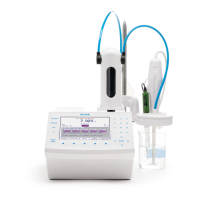Back Titration
A type of titration where an excess amount of titrant is added to a sample, forcing a sluggish reaction to go to completion. The
excess reagent is then “back” titrated with a second titrant.
Base
A chemical species that can accept one or more protons (hydrogen ions).
Biamperometric Indication
Uses a double platinum pin electrode to measure the current flow through a titration solution.
Bivoltametric Indication
Uses a double platinum pin electrode to measure the voltage required to maintain a constant current flow through a titration
solution while constant voltage is applied across the platinum elements of the electrode.
Burette
A graduated cylindrical piece of laboratory glassware that is used to dispense precise amounts of solution.
Complex Ion
A species where a central metal ion is covalently bonded to one or more electron donating groups called ligands.
Complexometric Titrations
Metal ions are titrated using a titrant that binds strongly to it. The titrants often contain Ethylenediaminetetraacetic Acid (EDTA)
or Cyclohexylenedinitrilotetraacetic Acid (CDTA).
Endpoint
The point were a titration is stopped because a physical change in the solution has indicated a completed titration. Titration
endpoints typically coincide with the equivalence point. A fixed value endpoint (pH or mV) can be used as well. The titration will
stop at the desired point regardless if the titration is complete.
Equivalence point
The point where the quantity of titrant is stoichiometrically equal to the quantity of analyte.
Formal
The theoretical number of equivalents per liter of the solution. It is used in solutions where the exact concentration of a species
may be affected by the other ions present, therefore the stated concentration may not be exactly correct.
Gravimetric Analysis
A quantitative determination of an analyte based on the mass of the solid.
Indicator Electrode
An electrode that responds to the species of interest. The electrode potential is proportional to the concentration or activity of that
ion in the solution being measured.
Indicators
Chemical indicators are typically organic dyes that change form under different physical conditions, causing a color change
that can be seen by an analyst. Typically used in manual titrations, chemical indicators have been replaced with electrometric
indicators, which are used with automatic titrators.
Inflection Point
The point on a titration curve were the second derivative curve changes signs.
Ion Selective Electrode (ISE)
An electrode that responds to a specific ion. The electrode potential is proportional to the concentration or activity of that ion in
the solution being measured.
Karl Fischer Titration
A titration that uses a chemical reaction that is specific for determining water.

